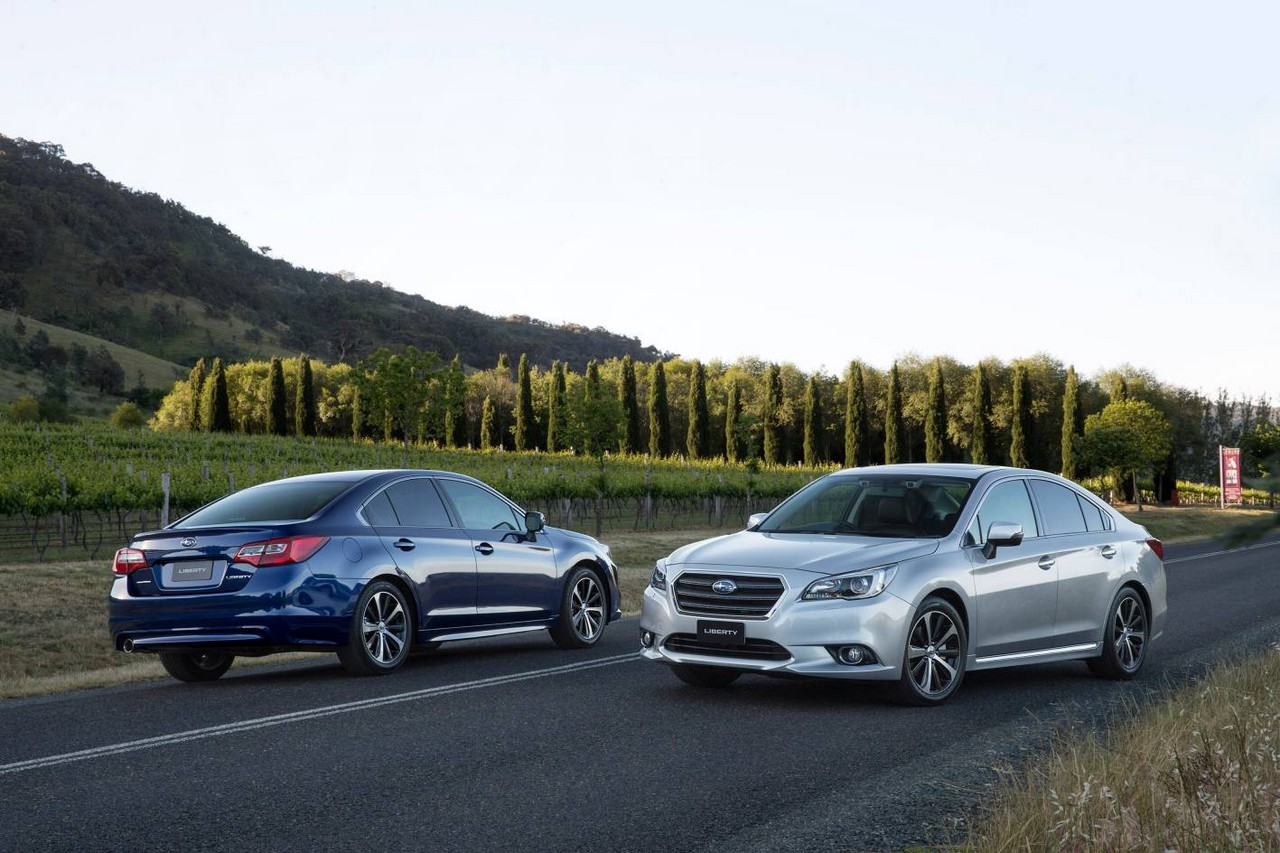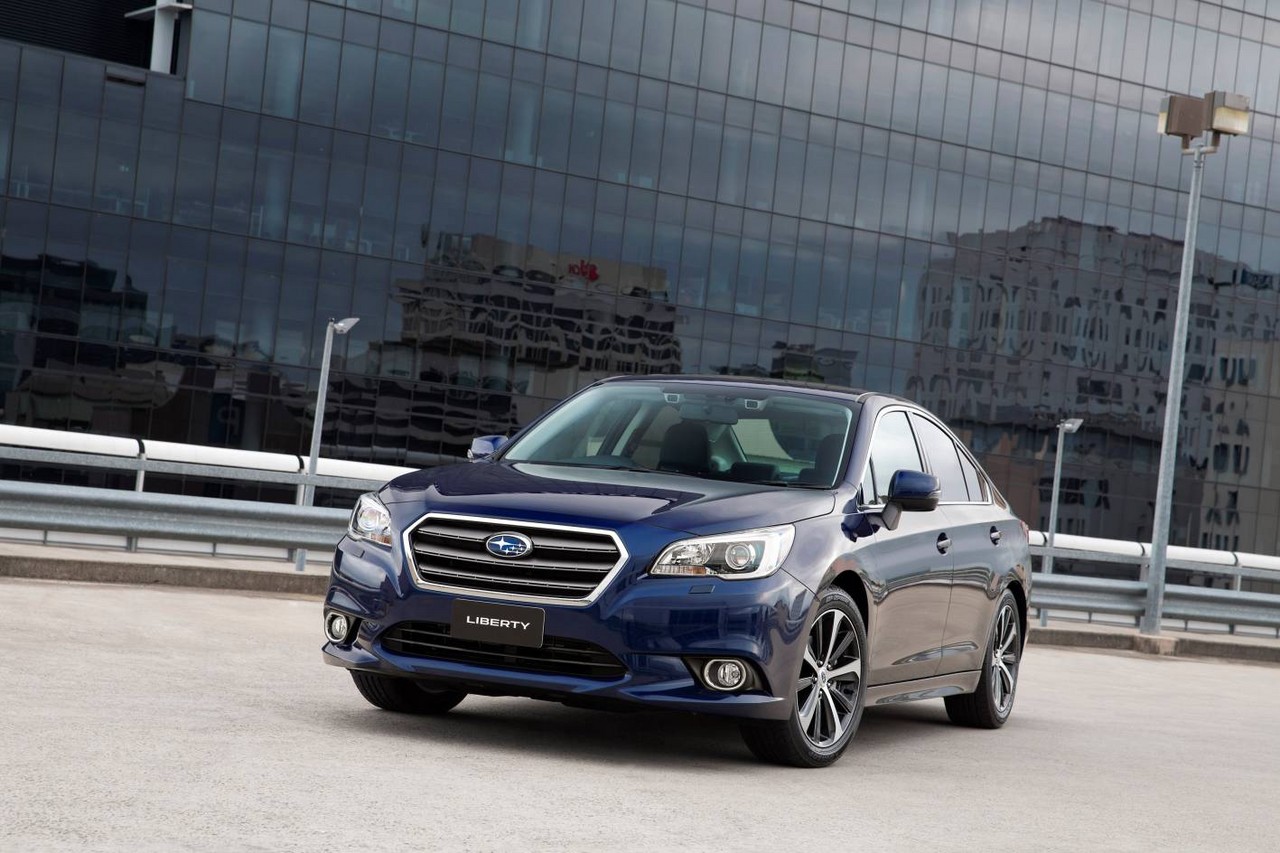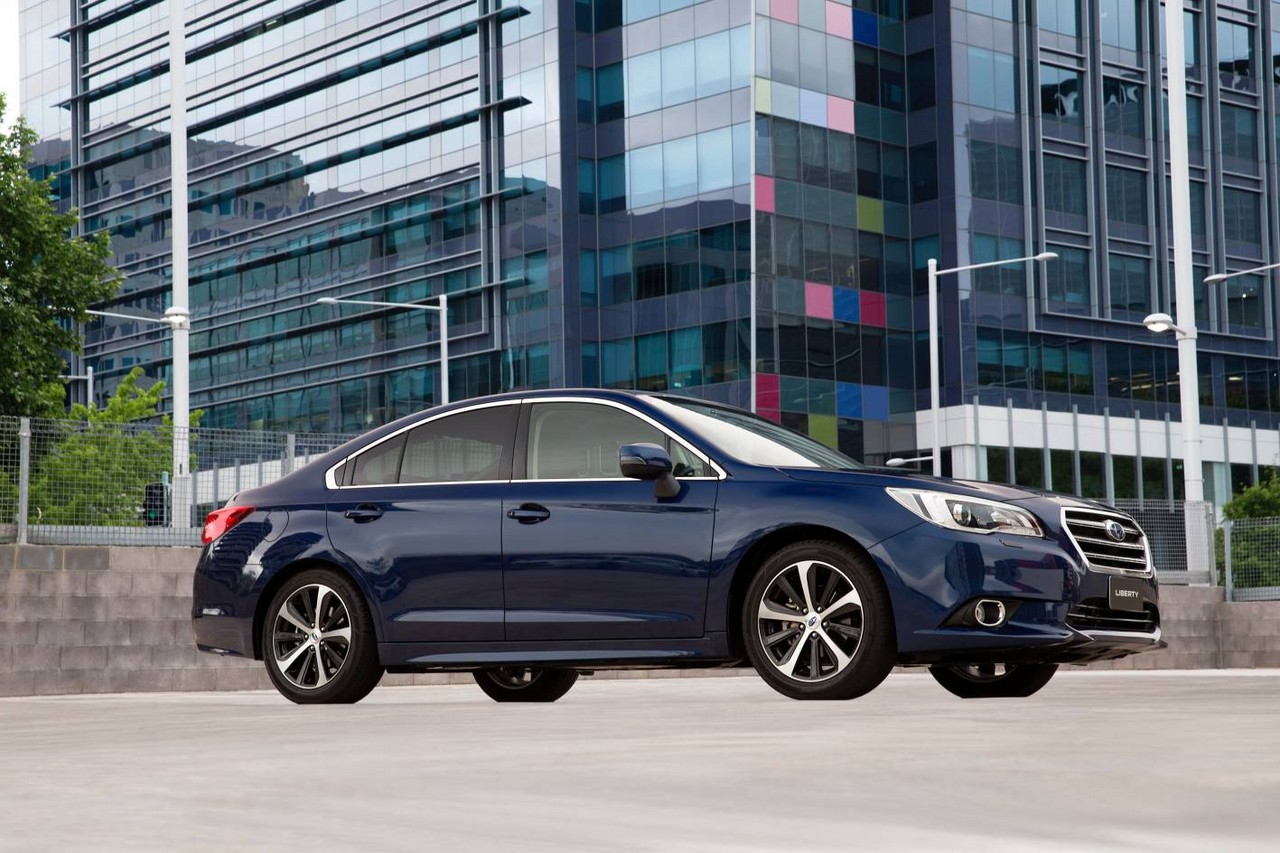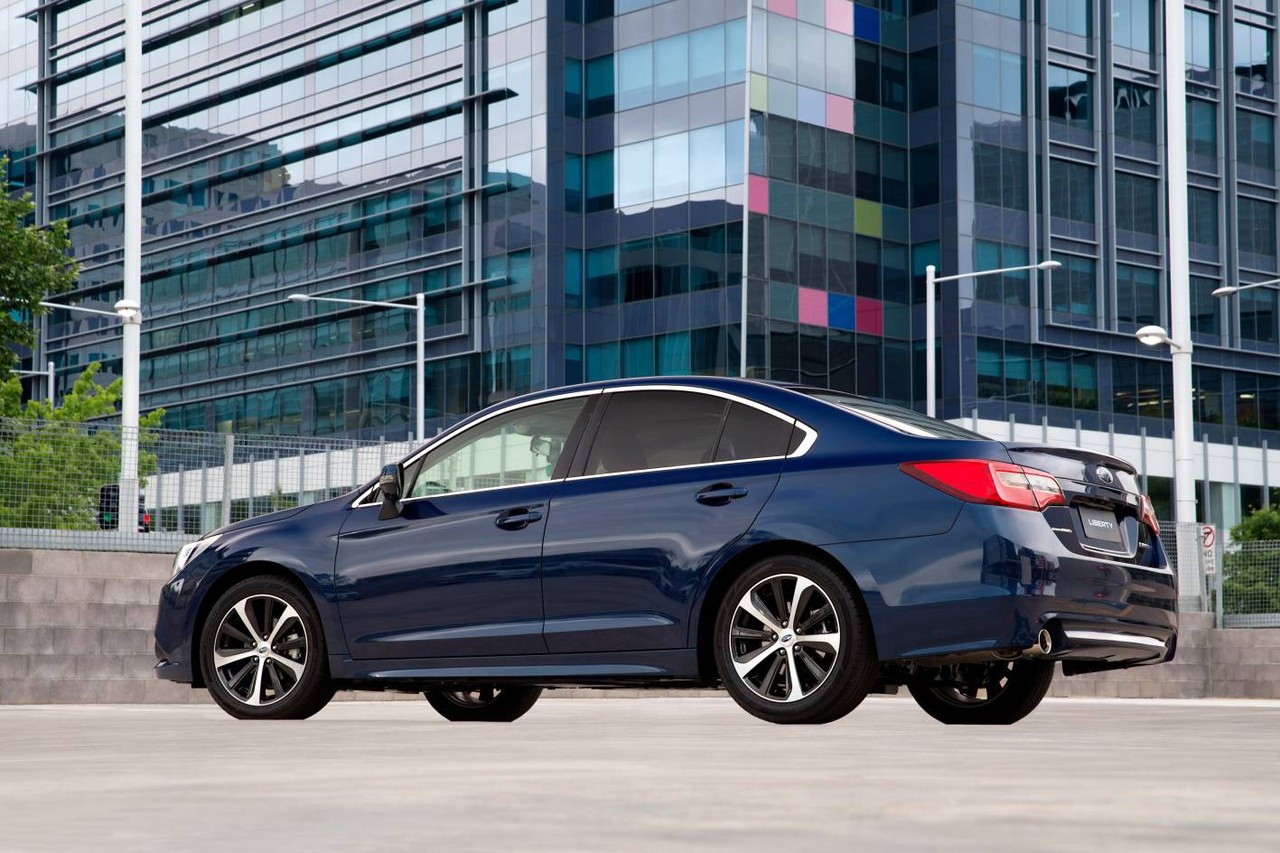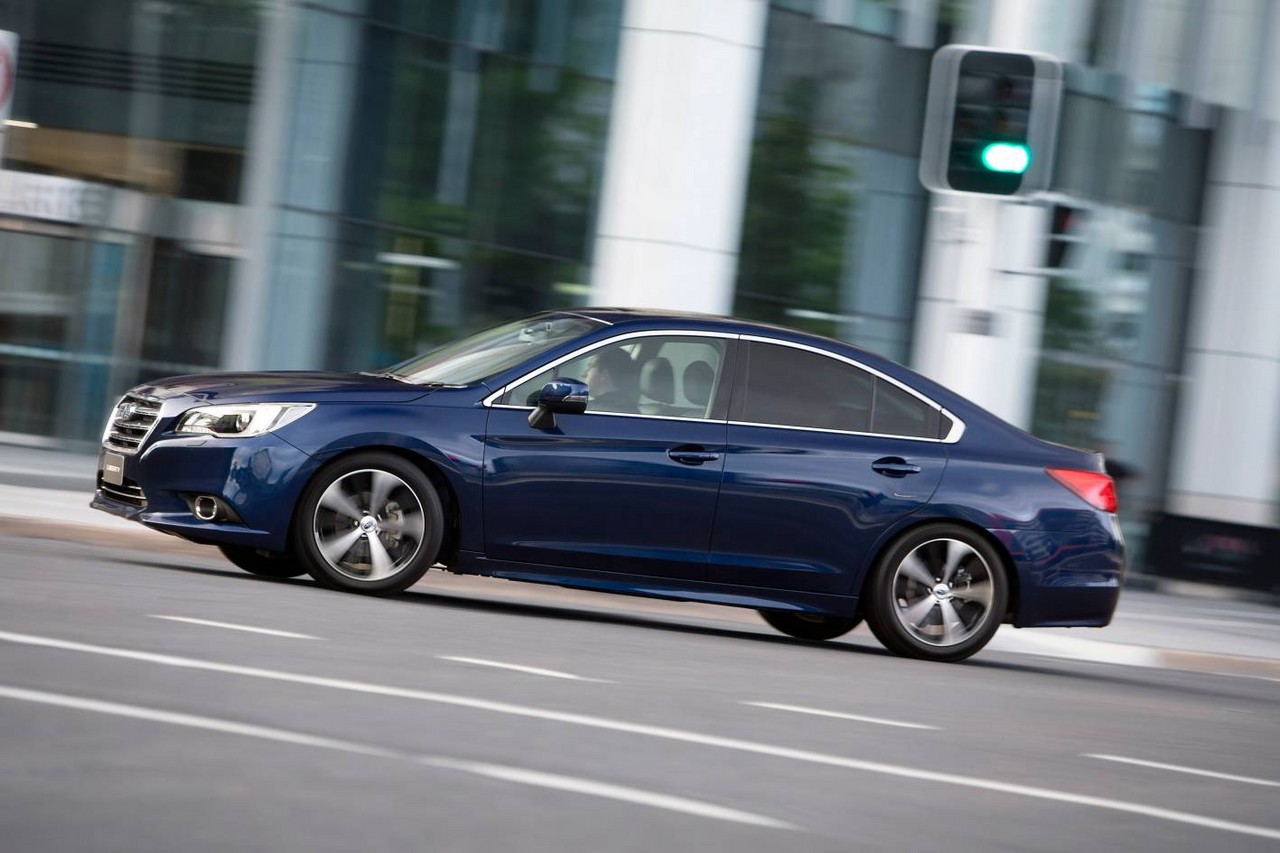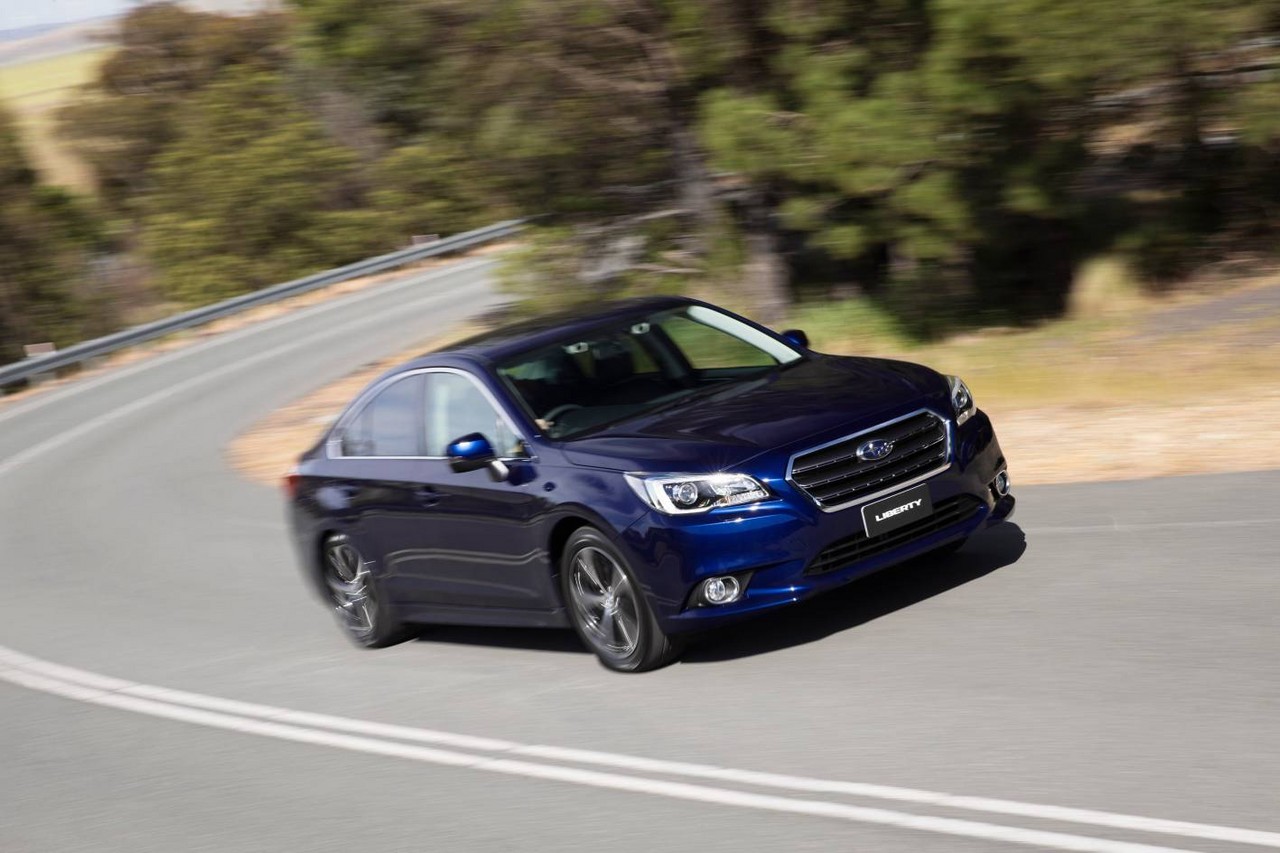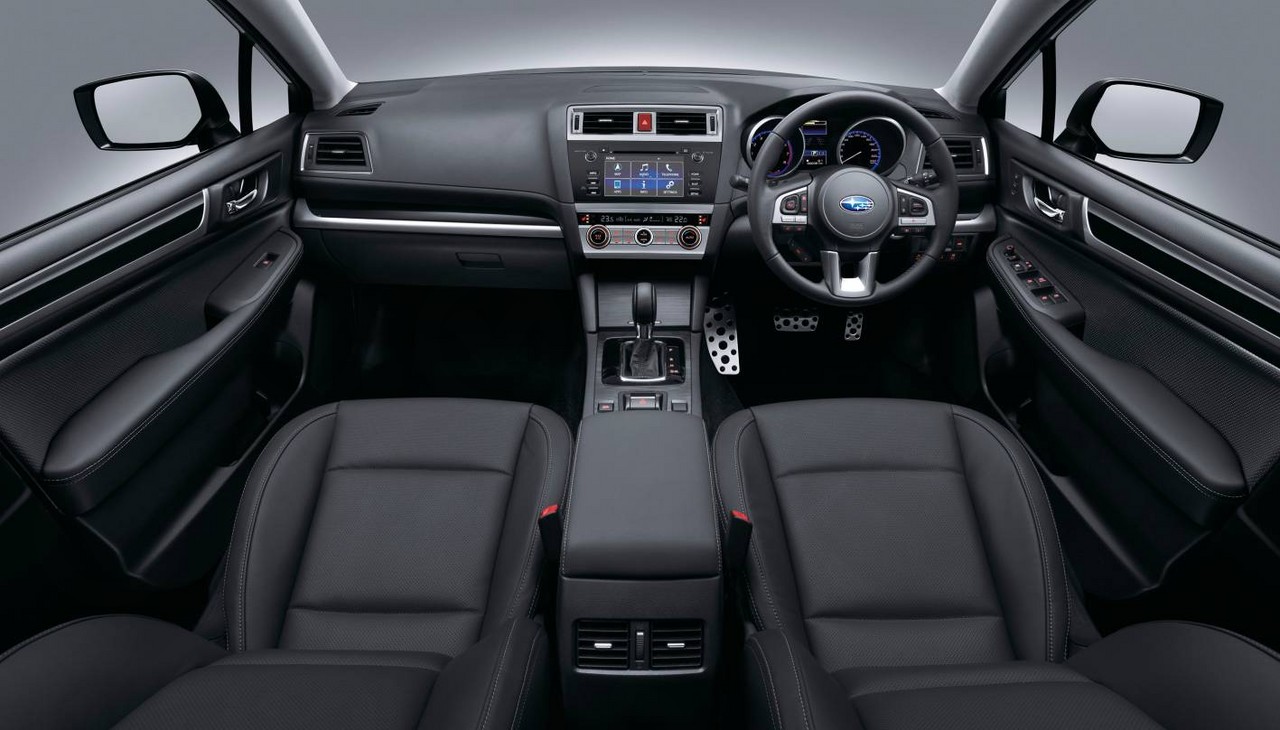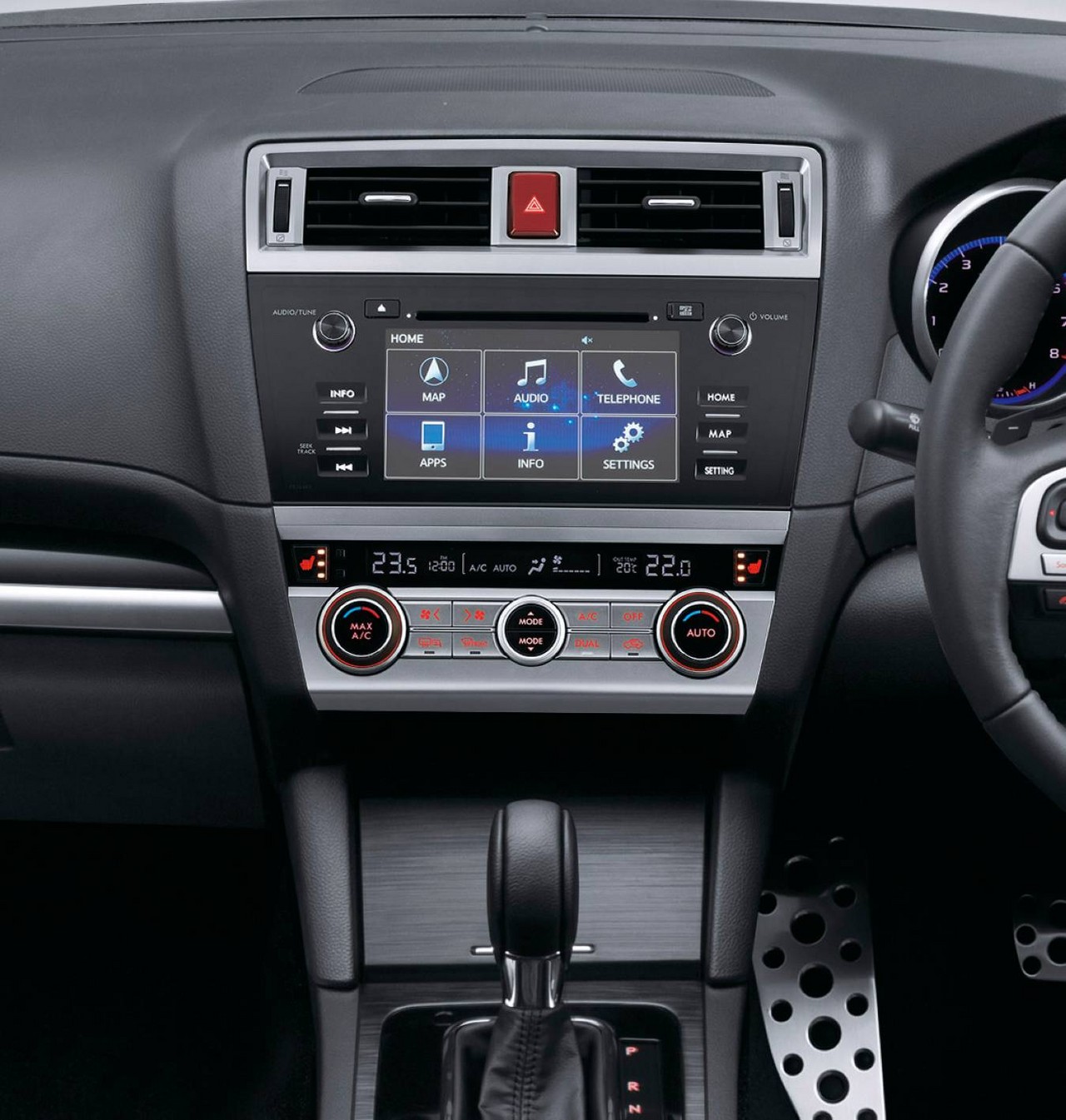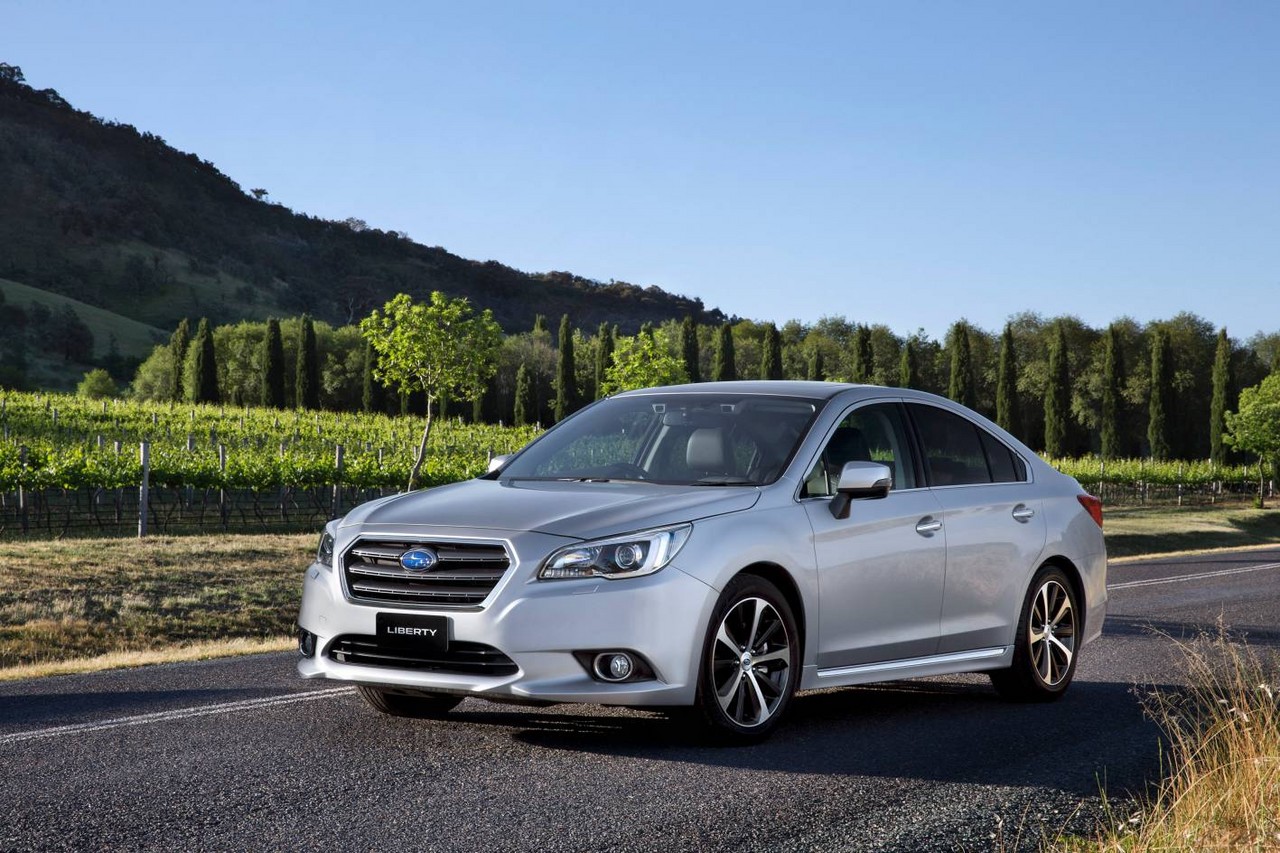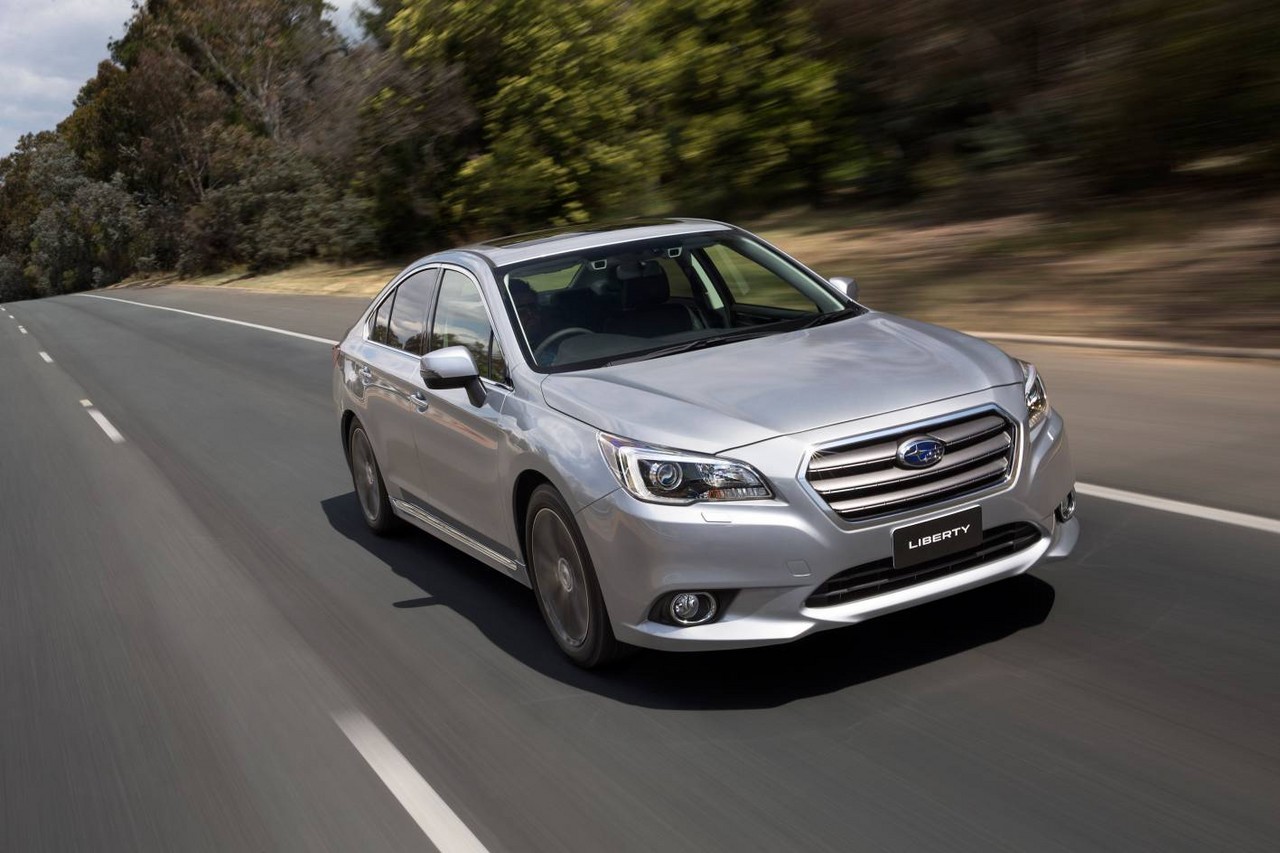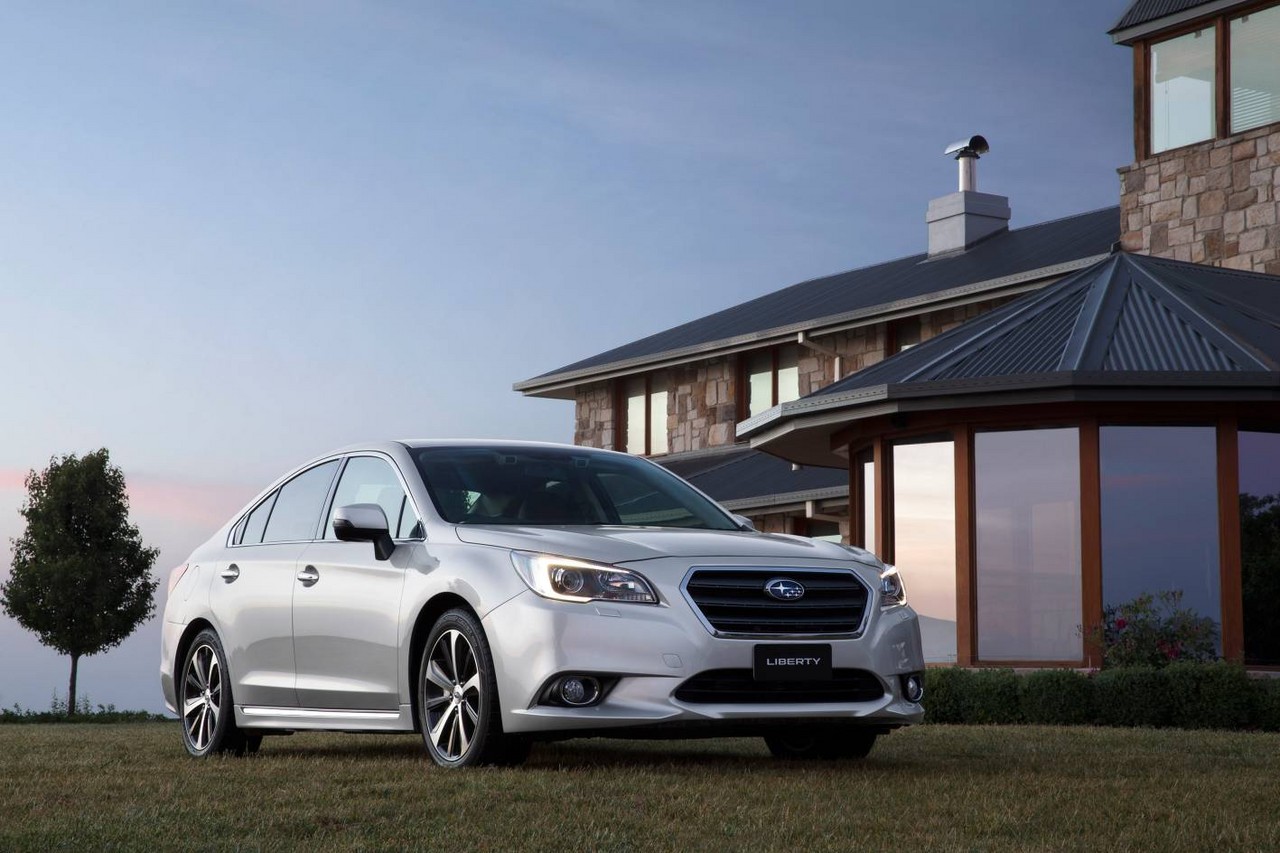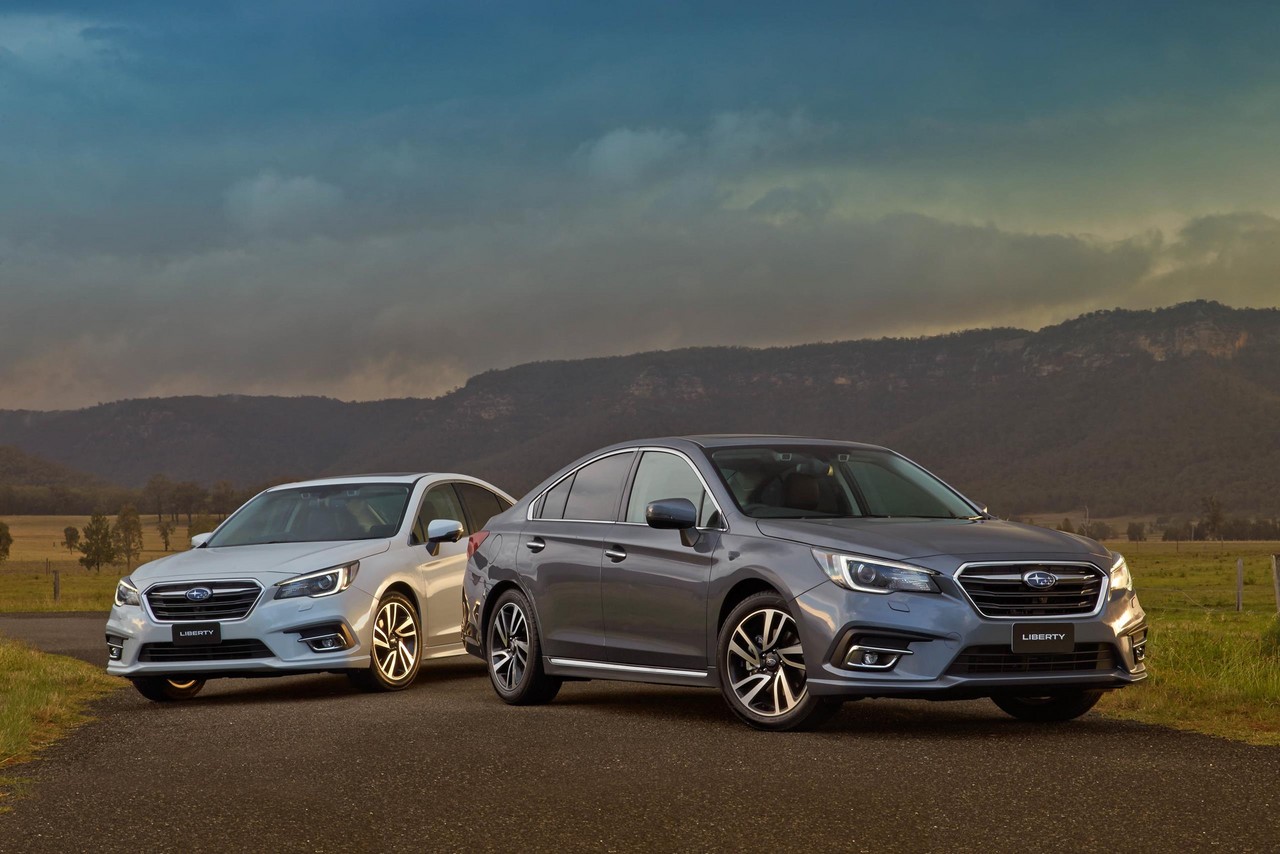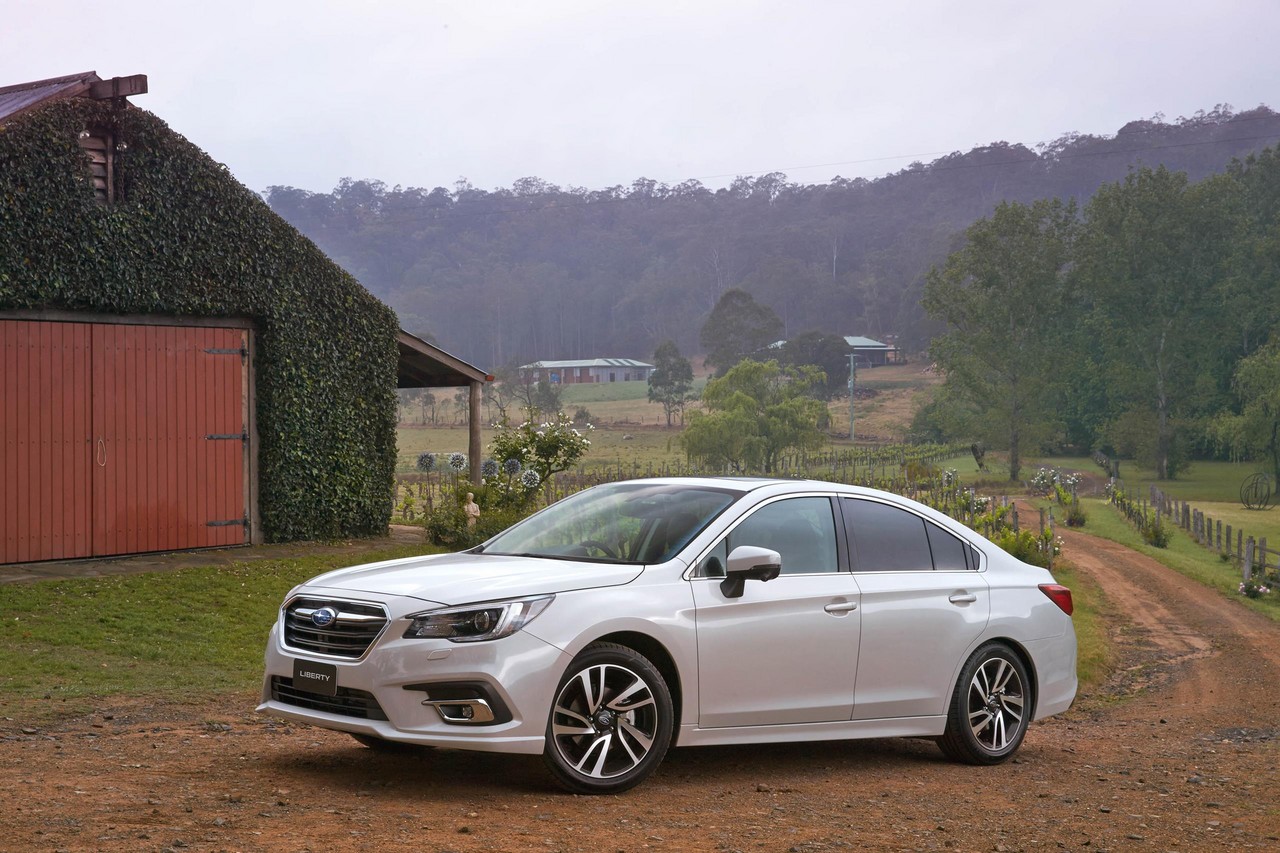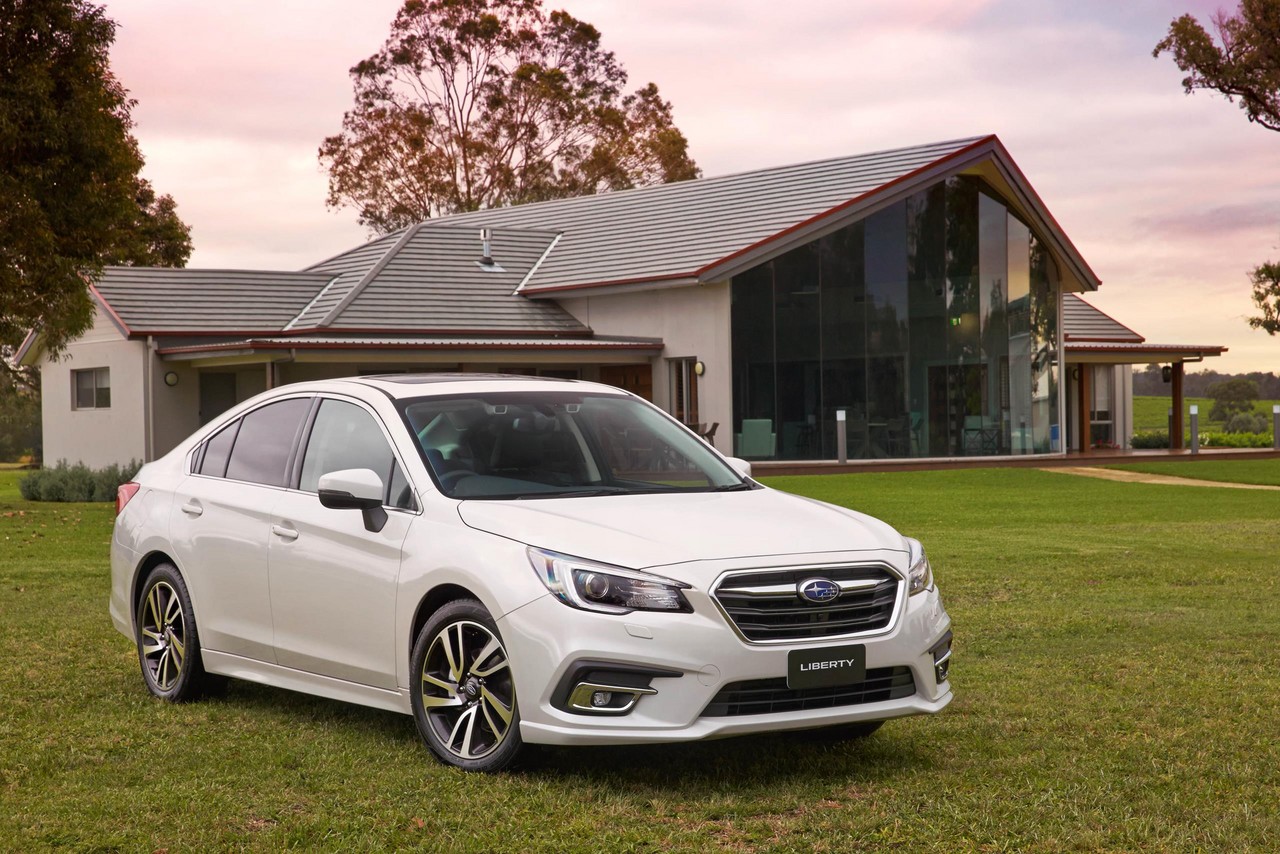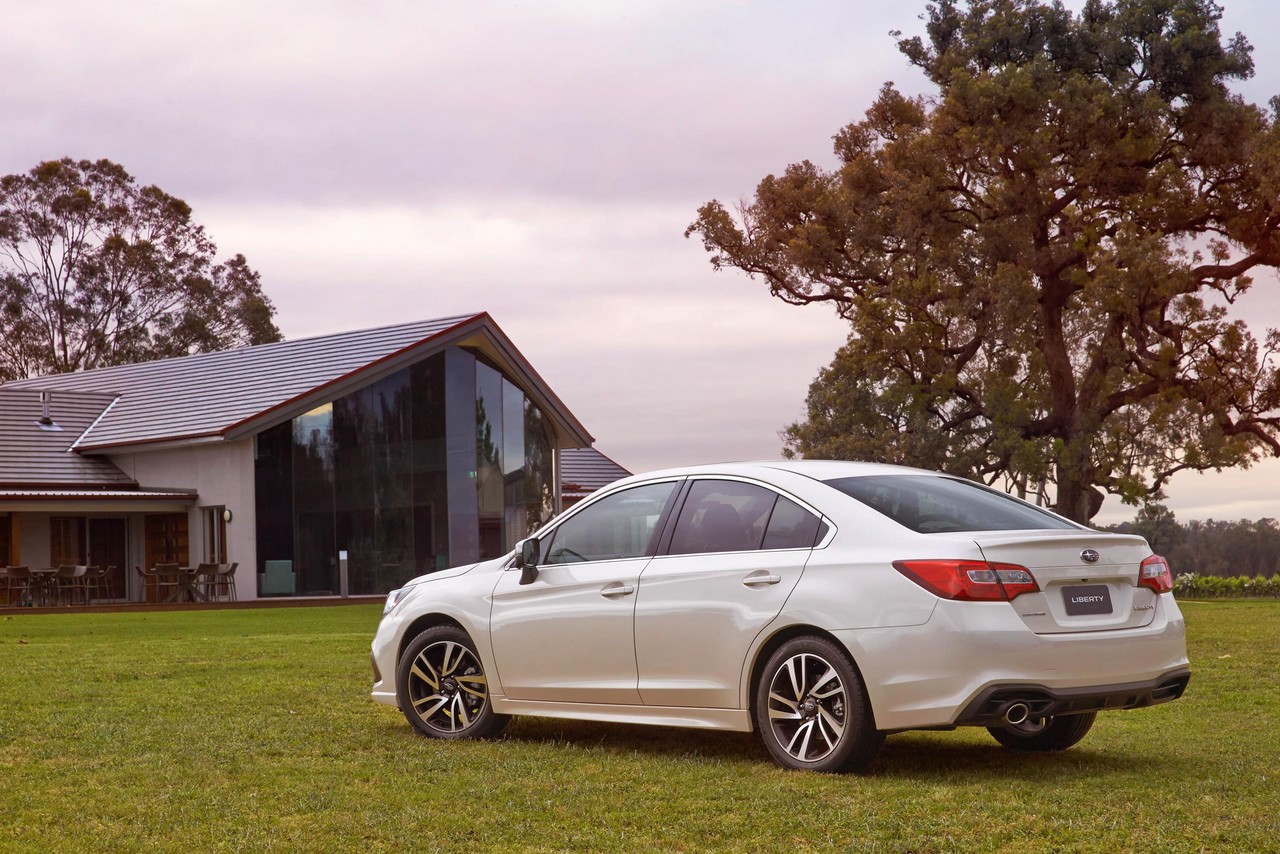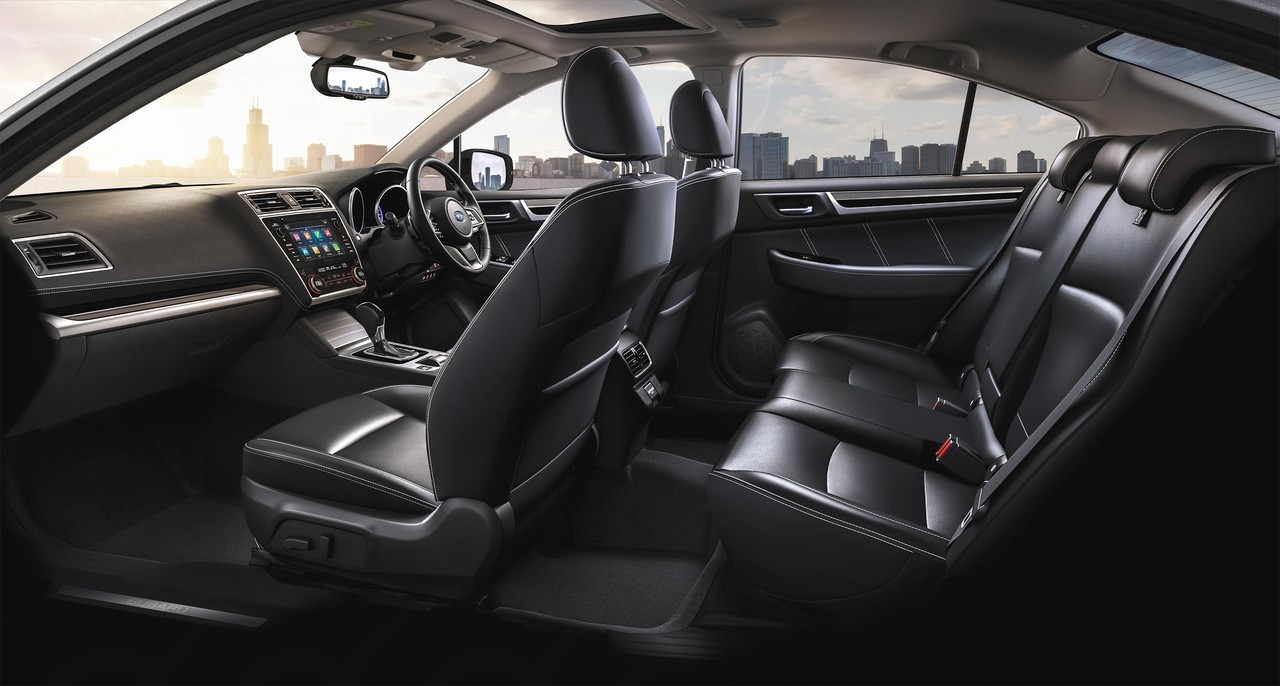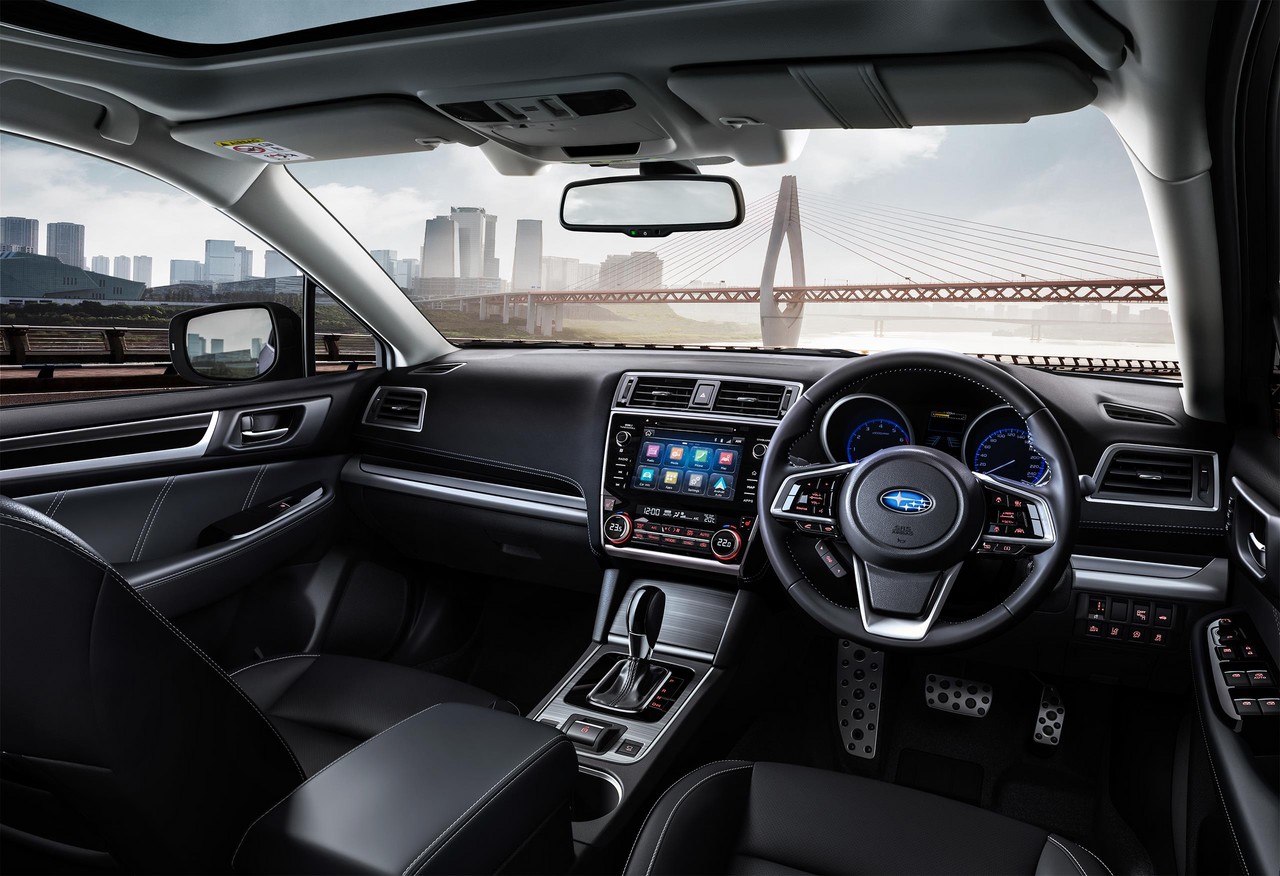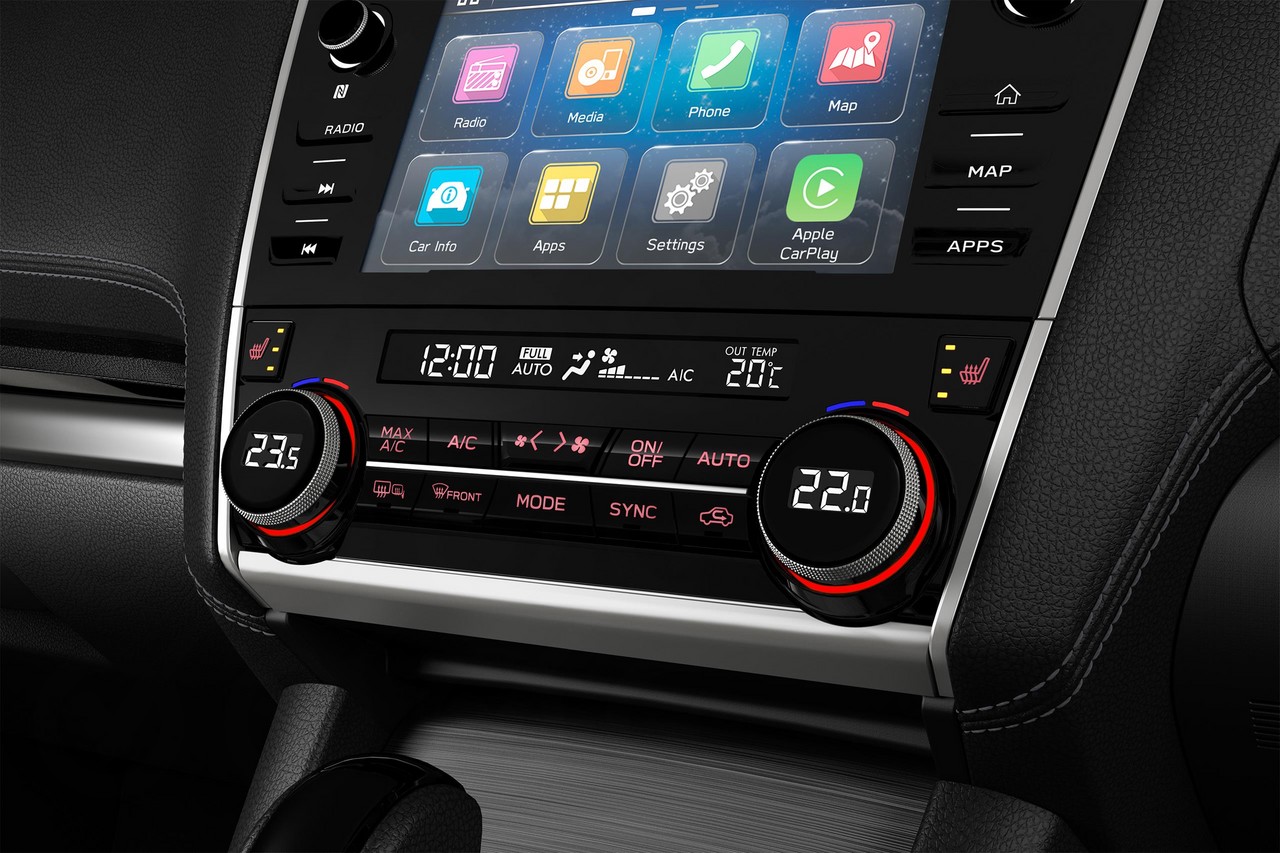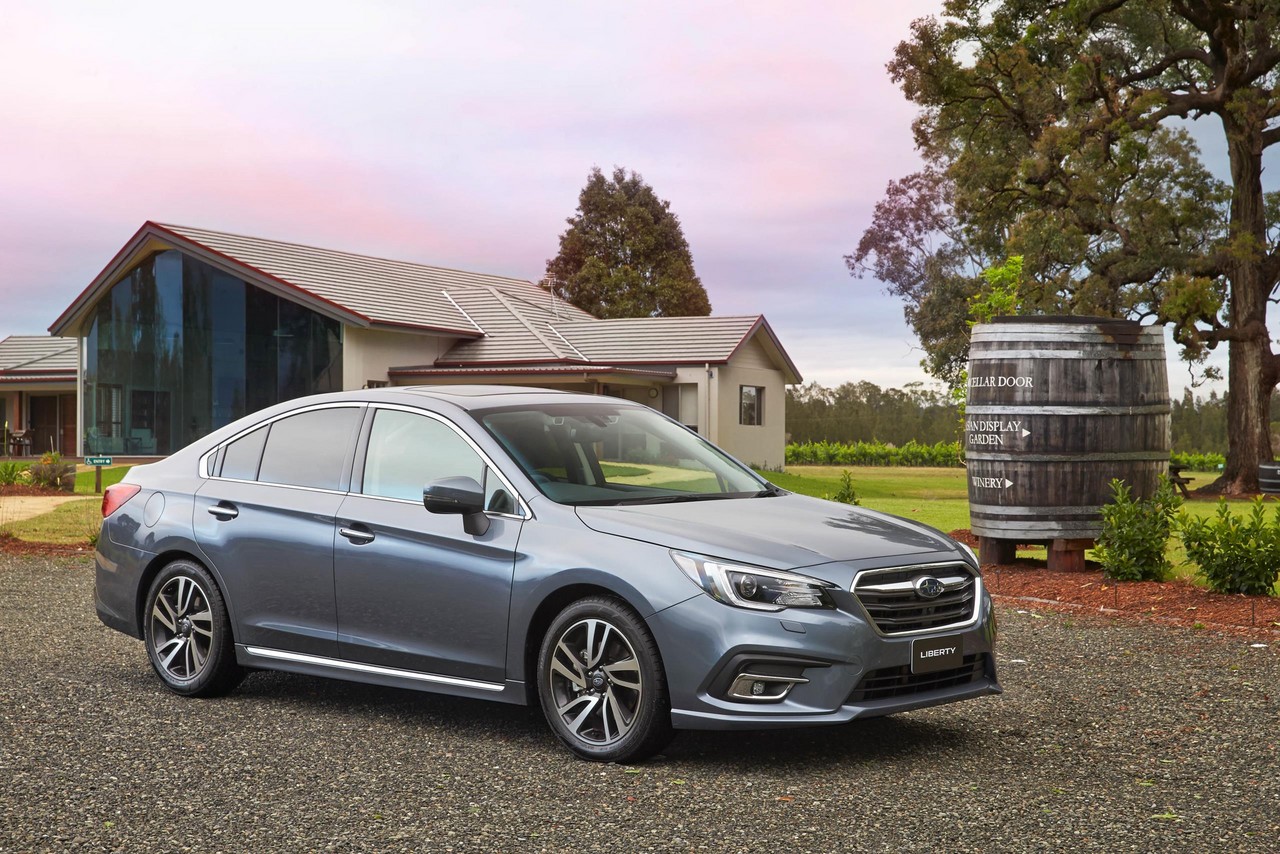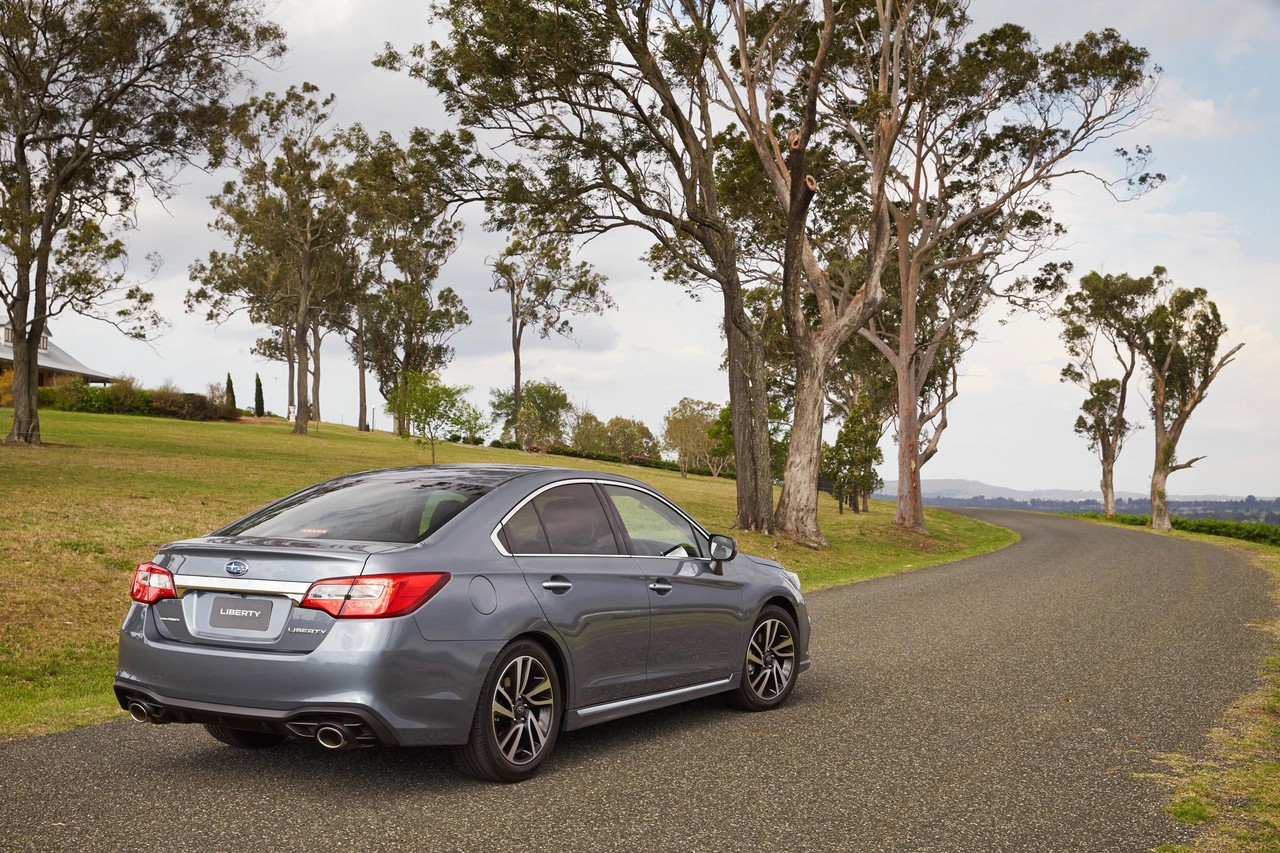
- Refined 3.6-litre F6 petrol engine
- All-wheel drive (AWD) traction
- Competent ride/handling balance
- Comfortable driving position
- Well-weighted steering provides good feedback
- For 2.5-litre engine, noise at higher rpm
- CVT makes clunking noise when moving into or from reverse
- Tyre noise on coarse chip surfaces
Review: Subaru BN.I Liberty (2014-17)
Overview
Released in Australia in December 2014, the Subaru BN Liberty was a mid-size, all-wheel drive sedan. Manufactured in Gunma, Japan, the BN Liberty was available with 2.5-litre four-cylinder and 3.6-litre six-cylinder horizontally-opposed petrol engines. Both engines were mated to continuously variable transmissions (CVTs or Subaru’s ‘Lineatronic’) which had six pre-set ratios and steering wheel gearshift paddles for sequential shifts.
FB25 and EZ36 engines
For the Liberty 2.5i, the 2.5-litre FB25 petrol engine had an open-deck aluminium alloy block, an aluminium alloy cylinder head, double overhead camshafts (chain-driven), four valves per cylinder, variable intake and exhaust valve timing (Subaru’s ‘Dual Active Valve Control System’) and a compression ratio of 10.3:1. For the BN Liberty and Subaru BS Outback , the FB25 petrol engine was updated and changes included:
- The introduction of an an ‘Automatic Stop Start’ system which enabled the engine to shut down when the vehicle was stationary in traffic to conserve fuel
- A thinner cylinder block (base thickness reduced from 3.5 mm to 3.2 mm);
- Larger intake valves (36 mm diameter, previously 34 mm);
- Increased valve pitch (41 mm, previously 39 mm);
- Reshaped valve position and intake ports for the Tumble Generator Valve (TGV);
- New pistons with raised crown surfaces for a higher compression ratio (previously 10.0:1) and new skirt coating to lower friction; and,
- A dedicated cooling circuit for exhaust gas recirculation (EGR).
For the Liberty 3.6R, the 3.6-litre EZ36D engine had an open-deck aluminium block, an aluminium cylinder head with parallel-flow cooling, double overhead camshafts (chain-driven), four valves per cylinder, variable intake and exhaust valve timing (Subaru’s ‘Dual Active Valve Control System’ or ‘Dual AVCS’) and a compression ratio of 10.5:1. The EZ36D engine did not have an ‘Automatic Stop Start’ function.
| Variant | Engine | Trans. | Peak power | Peak torque |
|---|---|---|---|---|
| 2.5i | 2.5-litre FB25 petrol F4 | 6sp CVT | 129 kW at 5800 rpm | 235 Nm at 4000 rpm |
| 3.6R | 3.6-litre EZ36D petrol F6 | 6sp CVT | 191 kW at 6000 rpm | 350 Nm at 4400 rpm |
Dimensions and body
Compared to the Subaru BM Liberty , the BN Liberty was 61 mm longer (at 4796 mm), 60 mm wider (1840 mm) and 5 mm lower (1500 mm), though wheelbase length was unchanged at 2750 mm. Furthermore, boot volume increased to 493 litres (from 476 litres).
Compared to its predecessor, design changes and the use of hot-pressed 980 MPa steels and hot-pressed high-strength reinforcing members contributed to a 167 per cent increase in torsional rigidity for the BN Liberty. Other changes included:
- A more raked windscreen, the base of which was brought forward by 51 mm;
- Improved aerodynamic efficiency, with 2.5i variants fitted with an Active Grille Shutter system as standard;
- An aluminium bonnet to reduce mass (by 7 kg); and,
- Door-mounted side view mirrors.
Steering and suspension
The BN Liberty had electric power-assisted steering, MacPherson strut front suspension and double wishbone rear suspension. In February 2016, shock absorber settings were revised to reduce impact harshness on sharp bumps; Subaru also claimed that handling was improved on coarse surfaces and that floor vibrations were reduced.
All-wheel drive (AWD): Active Torque Split
The Subaru BN Liberty was fitted with Subaru’s ‘Active Torque Split’ all-wheel drive system which used an electronically-controlled, hydraulic multi-plate transfer clutch (instead of a centre differential). In normal conditions, the system provided a 60:40 front:rear torque split but sensors – measuring wheel slip, throttle position and braking – could anticipate a loss of front-wheel traction and increase torque to the rear axle.
Safety equipment
Standard safety equipment for the BN Liberty included dual front airbags, a driver’s knee airbag, front seat-mounted side airbags, full-length curtain airbags (i.e. for front and rear occupants), ABS, electronic brake force distribution, brake assist, electronic stability control, traction control and front seatbelts with pretensioners and load limiters.
As standard, the BN Liberty was fitted with Subaru’s EyeSight driver-assist system which used a stereo camera to provide the following functions –
- Adaptive Cruise Control: could maintain a safe distance from the vehicle in front by braking and/or accelerating as required to maintain the driver-selected target speed and travelling distance. ACC could operate at speeds up to 145 km/h and could detect the red brake lights of the vehicle ahead for smoother deceleration and acceleration;
- Pre-Collision Braking: could detect if a collision was imminent with an object in front of the vehicle and autonomously apply the brakes to avoid or minimise the severity of the collision. Pre-Collision Braking could detect objects if the relative speed difference to the vehicle ahead was less than 50 km/h or if the speed difference to a pedestrian was less than 35 km/h;
- Pre-Collision Braking Assist: could increase braking assistance if the driver’s braking input was insufficient;
- Pre-Collision Steering Assist: if there was a possibility of colliding with a car or object in front and the driver used the steering wheel to take evasive action, Pre-Collision Steering Assist could alter the stability control settings to assist the driver to avoid the collision;
- Pre-Collision Throttle Management: if the driver mistakenly selected drive instead of reverse when the vehicle was stationary or travelling slowly, and objects were detected in front of the vehicle, Pre-Collision Throttle Management would 1) emit visual and audible warnings, and, 2) restrict engine output;
- Lane Sway Warning: Lane Sway Warning operated at speeds of approximately 60 km/h and could detect if the vehicle was wandering or drifting in its lane. If detected, Lane Sway Warning would warn the driver with a buzzer and flashing indicator;
- Lane Departure Warning: Lane Departure Warning, however, operated at speeds of approximately 50 km/h and above and would warn the driver (with a buzzer and flashing indicator) if the vehicle was about to depart from its lane without signalling; and,
- Front Vehicle Start Alert: when stationary and traffic ahead had started to move, Lead Vehicle Start Alert would prompt the driver to take action with a buzzer and flashing indicator.
In February 2016, ‘Emergency Stop Signal’ (ESS) brake lights were introduced which would flash rapidly during emergency braking manoeuvres to warn following traffic. From February 2016, the Liberty 2.5i Premium and 3.6R were also equipped with Subaru’s ‘Vision Assist’ package which included:
- Blind Spot Monitoring;
- Lane Change Assist;
- Rear Cross Traffic Alert;
- High Beam Assist; and,
- An auto-dimming rear view mirror.
ANCAP and Euro NCAP testing
In ANCAP crash testing , the 2014 Subaru BS Outback received a five star adult occupant protection rating with a score of 35.99 out of 37 and this result was also applied to the BN Liberty sedan. In the offset crash test, occupant protection for the driver’s head, thighs and feet were rated as good, though chest and lower leg protection were rated as acceptable (i.e. a slight risk of serious injury). In the side impact and pole tests, maximum points were awarded.
In Euro NCAP testing , the 2014 Subaru BS Outback received a five star safety rating which included an 85 per cent adult occupant protection rating and an 87 per cent child occupant protection rating. In the offset crash test, protection of the driver’s head, thighs and feet were rated as good, though chest and lower leg protection were rated as adequate (i.e. a slight risk of serious injury). In the side impact test, driver protection was rated as good in all areas. In the more severe pole test, however, protection of the driver’s chest and abdomen were rated as adequate.
Features: Liberty 2.5i and 2.5i Premium
Standard features for the Liberty 2.5i included 18-inch alloy wheels with 225/50 R18 95W Dunlop SP Sport Maxx 050 tyres (and a full-size spare), a six speaker sound system with a CD player, MP3-compatibility, auxiliary inputs (3.5 mm/USB/iPod), Bluetooth mobile phone connectivity and audio streaming, dual-zone climate control air conditioning, cruise control, front fog lights, a reversing camera, automatic headlights, rain-sensing wipers, a leather-wrapped steering wheel with gearshift paddles, 60/40 split and folding rear seats, remote central locking, power windows and mirrors, a height and reach adjustable steering column, a height adjustable driver’s seat, rear privacy glass, vanity mirrors, a trip computer and an immobiliser.
The Liberty 2.5i Premium was further equipped with 18-inch alloy wheels, an enhanced infotainment system, a factory-fitted satellite navigation system with Pandora, leather trim, power adjustable and heated front seats, LED low beam headlights with washers, keyless entry (i.e. proximity key), power folding and heated mirrors, front wiper de-icer, push-button start, power sunroof and piano black interior trim. Visually, the Premium and 3.6R variants could be identified by their chrome fog lights surrounds.
Features: Liberty 3.6R
Compared to the 2.5i Premium, the Liberty 3.6R was distinguished by its harman kardon sound system with twelve speakers and subwoofer; visual cues included a chrome side sill and rear garnishes and dual exhaust system.
February 2016 update
From February 2016,
- The Liberty 2.5i was further equipped with power folding door mirrors; and,
- For the Liberty 2.5i Premium and 3.6R with satellite navigation, a new ‘Subaru Map Update Program’ was introduced which provided for the latest map version to be installed before vehicle delivery and a three year subscription to map updates.
Paint colours
The BN Liberty was available with the following paint colours:
- Crystal White Pearl;
- Platinum Gray Metallic;
- Tungsten Metallic;
- Lapis Blue Pearl;
- Ice Silver Metallic;
- Dark Gray Metallic;
- Crystal Black Silica;
- Venetian Red Pearl; and,
- Deep Sea Blue Pearl.
Brochure
Related links
Review: Subaru BN.II Liberty (2018-20)
Overview
Released in Australia in February 2018, the Subaru BN.II Liberty could be identified by its new bumpers, front grille, headlights with integrated daytime running lights (DRLs), more aerodynamic door mirrors that had 20 mm shorter stems and integrated LED indicators and new 18-inch alloy wheel designs.
Inside, the Subaru BN.II Liberty had a new steering wheel, a larger centre dashboard panel with high gloss black surrounds and silver frame, and ‘third generation’ head units for the infotainment system which had a graphical user interface (GUI) with smartphone-like usability and buttons, Apple CarPlay and Android Auto smartphone integration and voice recognition.
Other changes for the Subaru BN.II Liberty included:
- Revised shock absorbers to improve ride quality and reduce roll;
- The electric power-assisted steering (EPS) was tuned to respond ‘in a more linear fashion to driver input’, particularly during lane changes at highway speeds; and,
- Changes were made to the braking system for more ‘linear response’ and ‘higher rigidity pedal feel’.
Mechanical changes: Liberty 2.5i (FB25)
For the Subaru BN.II Liberty 2.5i, the following changes were introduced for the FB25 engine:
- The mass of the crank pulley, crankshaft and connecting rods was reduced;
- Mirror surfacing was introduced for all intake and exhaust valves to reduce friction;
- Ignition timing was adjusted to reduce engine noise; and,
- The Magnetic Pick-Up (MPU) crank angle sensor was replaced by a Magnetic Resistant Element (MRE) sensor. The tooth profile of the crankshaft sensor plate was also changed to increase crank sensor detection accuracy.
For the BN.II Liberty 2.5i’s continuously variable transmission (CVT):
- A seven-speed manual mode was introduced. In manual mode, torque reduction control was changed to improve upshift response;
- The range of ratios was expanded (from 6.28 to 7.03) to improve fuel economy;
- A short pitch chain was introduced to reduce cabin noise;
- Changes to the shifter assembly provided ‘smoother, natural shifting from Park to Drive or Reverse’;
- A lighter transmission case (by 470 grams) was introduced; and,
- Rear differential oil was changed from 75W90 to 75W80 to reduce resistance and improve fuel efficiency.
| Variant | Engine | Trans. | Peak power | Peak torque |
|---|---|---|---|---|
| 2.5i | 2.5-litre FB25 petrol F4 | 7sp CVT | 129 kW at 5800 rpm | 235 Nm at 4000 rpm |
| 3.6R | 3.6-litre EZ36D petrol F6 | 6sp CVT | 191 kW at 6000 rpm | 350 Nm at 4400 rpm |
Safety equipment
The Subaru BN.II Liberty was equipped with Subaru’s third-generation ‘EyeSight’ driver assist system which used a CMOS (complementary metal-oxide semi-conductor) camera for improved recognition of low-contrast objects. For the Subaru BN.II Liberty, changes to safety equipment included –
- Lane Keep Assist (LKA): fitted as standard, LKA operated at speeds above 60 km/h and would provide corrective steering assistance to keep the vehicle in its lane if it was about to drift outside of it and the turn indicators had not been applied; and,
- The pre-collision braking system could detect relative speed differences up to 50 km/h (previously 30 km/h).
Beyond this, the Subaru BN.II Liberty 2.5i Premium and 3.6R variants were equipped with the following ‘Vision Assist’ technologies –
- Steering Responsive Headlights (SRH) that would change direction with the steering wheel;
- Adaptive Driving Beam (ADB) headlights that would automatically 1) switch between high and low beams, and 2) mask their illumination to avoid dazzling other drivers;
- Front View Monitor (FVM): operating at speeds under 20 km/h, images from a front-mounted camera could be shown on the Multi-Function Display. As such, the Front View Monitor enabled the driver to check for approaching vehicles or pedestrians at intersections with poor visibility; and,
- ‘Side View Monitor’ (SVM): operating at speeds under 20 km/h, SVM used a camera in the passenger side mirror and showed – on the multi-function display – the distance from the kerb (or a parked vehicle) when reversing into a parking space.
Features
The Subaru BN.II Liberty introduced a new touchscreen audio unit that featured Apple CarPlay and Google Android for smartphone integration. For the BN.II Liberty 2.5i variants, the touchscreen had a 6.5-inch diameter; for the Liberty 2.5i Premium and 3.6R, the touchscreen had an 8.0-inch diameter and a factory-fitted TomTom navigation system. For the BN.II Liberty, the rear of the centre console had two USB ports that were accessible to rear seat passengers.
Related links
